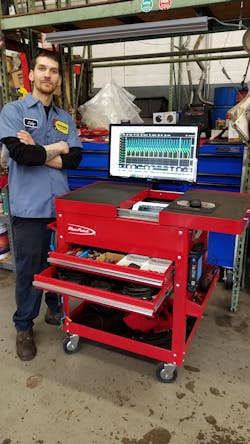For Rick Urso, a toolbox is not his go-to tool storage system; it’s a mobile diagnostic cart. Urso has been a technician at his father’s shop in Oaklawn, Illinois, for over 15 years and handles all the diagnostics. About a year ago, he purchased a Snap-on KRBCSST Series Blue-Point Roll Cart and has since turned it into his ideal diagnostic cart.
His family-run shop does everything from maintenance to engine replacements, so diagnostics are key. As Urso puts it, they are a one-stop shop.
As diagnostic tools and equipment are becoming more common and perhaps crucial for shops to own, diagnostic carts are becoming more popular.
“The diagnostics that we are doing nowadays on vehicles really require different [diagnostic] tools together, and the cart makes it so much easier and faster,” Urso says.
When Urso purchased the roll cart, it didn’t have much on it. At the time, he just had a scan tool. Over the course of the year, he has slowly invested in more diagnostic tools and started modifying the cart to fit his needs. The first thing he added was a 24” monitor for a PicoScope that he bought. He mounted the monitor to the back of the cart for easy viewing.
He then welded exhaust brackets to the side of the cart to access the PicoScope and its 10’ test leads more easily.
“The combination of the big screen and having the PicoScope mounted on the side makes [the diagnostic process] really efficient,” he notes.
Urso continued to customize his cart to make it as easy and accessible as possible for diagnostic testing.
Currently, the diagnostic cart features compartment organizers, four caster wheels that lock into place (replacing the original casters), a locking feature, and a surge protector. The surge protector is connected to a 600V battery backup to extend the battery life of his monitor and other components, allowing him to move the cart around the shop and bays as needed without having to be plugged into a wall outlet.
The diagnostic cart measures 38” high, 29.5” wide, and 21.5” deep and is able to hold all the different testing equipment Urso needs.
The top lid of the diagnostic cart slides open and is able to lock, a feature that Urso appreciates. This compartment is where he stores his laptop and scan tool for safekeeping.
Other items found within the cart include a PicoScope, a monitor, a WPS500 Pressure Transducer (his favorite diagnostic tool), a Nicholson Pulse Sensor, a Power Probe IV, various back probes, low amp probes, fused current loops, a CAN breakout box, a multimeter, and accessories.
For the time being, Urso says he’ll be “taking it easy” on adding more to his cart, noting that it’s already a pretty expensive set up with everything he’s invested.
“I definitely plan on investing more into the cart … our [industry] is always changing and evolving,” he says. “We have to keep up with the latest technology.”
Until then, the mobile cart will continue to help the technician diagnose vehicles faster and more efficiently.
About the Author
Kayla Nadler
Associate Editor | Vehicle Repair Group
Kayla (Oschmann) Nadler was previously an associate editor for the Vehicle Repair Group.
With an education in journalism and public relations, Nadler contributed to Professional Tool & Equipment News (PTEN) and Professional Distributor magazines, as well as VehicleServicePros.com.

